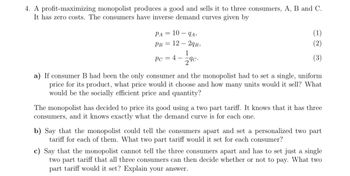4. A profit-maximizing monopolist produces a good and sells it to three consumers, A, B and C. It has zero costs. The consumers have inverse demand curves given by PA = 10 - 9A, PB 12 29B, 1 Pc = 4- 29c. (1) (2) (3) a) If consumer B had been the only consumer and the monopolist had to set a single, uniform price for its product, what price would it choose and how many units would it sell? What would be the socially efficient price and quantity? The monopolist has decided to price its good using a two part tariff. It knows that it has three consumers, and it knows exactly what the demand curve is for each one. b) Say that the monopolist could tell the consumers apart and set a personalized two part tariff for each of them. What two part tariff would it set for each consumer? c) Say that the monopolist cannot tell the three consumers apart and has to set just a single two part tariff that all three consumers can then decide whether or not to pay. What two part tariff would it set? Explain your answer.
4. A profit-maximizing monopolist produces a good and sells it to three consumers, A, B and C. It has zero costs. The consumers have inverse demand curves given by PA = 10 - 9A, PB 12 29B, 1 Pc = 4- 29c. (1) (2) (3) a) If consumer B had been the only consumer and the monopolist had to set a single, uniform price for its product, what price would it choose and how many units would it sell? What would be the socially efficient price and quantity? The monopolist has decided to price its good using a two part tariff. It knows that it has three consumers, and it knows exactly what the demand curve is for each one. b) Say that the monopolist could tell the consumers apart and set a personalized two part tariff for each of them. What two part tariff would it set for each consumer? c) Say that the monopolist cannot tell the three consumers apart and has to set just a single two part tariff that all three consumers can then decide whether or not to pay. What two part tariff would it set? Explain your answer.
Oh no! Our experts couldn't answer your question.
Don't worry! We won't leave you hanging. Plus, we're giving you back one question for the inconvenience.
Submit your question and receive a step-by-step explanation from our experts in as fast as 30 minutes.
You have no more questions left.
Message from our expert:
It looks like you may have submitted a graded question that, per our Honor Code, experts cannot answer. We've credited a question to your account.
Your Question:

Transcribed Image Text:4. A profit-maximizing monopolist produces a good and sells it to three consumers, A, B and C.
It has zero costs. The consumers have inverse demand curves given by
PA = 10 - 9A,
PB 12
29B,
1
Pc = 4- 29c.
(1)
(2)
(3)
a) If consumer B had been the only consumer and the monopolist had to set a single, uniform
price for its product, what price would it choose and how many units would it sell? What
would be the socially efficient price and quantity?
The monopolist has decided to price its good using a two part tariff. It knows that it has three
consumers, and it knows exactly what the demand curve is for each one.
b) Say that the monopolist could tell the consumers apart and set a personalized two part
tariff for each of them. What two part tariff would it set for each consumer?
c) Say that the monopolist cannot tell the three consumers apart and has to set just a single
two part tariff that all three consumers can then decide whether or not to pay. What two
part tariff would it set? Explain your answer.
Knowledge Booster
Learn more about
Need a deep-dive on the concept behind this application? Look no further. Learn more about this topic, economics and related others by exploring similar questions and additional content below.Recommended textbooks for you


Managerial Economics: Applications, Strategies an…
Economics
ISBN:
9781305506381
Author:
James R. McGuigan, R. Charles Moyer, Frederick H.deB. Harris
Publisher:
Cengage Learning



Managerial Economics: Applications, Strategies an…
Economics
ISBN:
9781305506381
Author:
James R. McGuigan, R. Charles Moyer, Frederick H.deB. Harris
Publisher:
Cengage Learning




